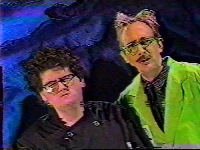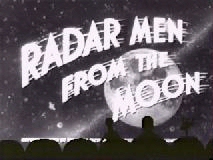
|
WELCOME!
FEATURES
ACEG: SEASON SEVEN
CHAT LOGS
DADDY-O'S DRIVE-IN DIRT
DVD LIST
EPISODE GUIDE
JUST THE FAQS
MAILING LIST
PRINT ARCHIVES
SEARCH ME!
SHOW HISTORY
TAPE TRADING
TORGO'S ROLODEX
THE UMBILICUS
WARD E
E-MAIL US!
SCI FI ARCHIVES
|
Part 4: The Big Time (1989-90)In the KTMA episodes, the Mads (as the Mad Scientists Dr. Forrester and Dr. Erhardt were known) had spoken to Joel from what was supposed to be a lab in Gizmonic Institute. It was never suggested that the movie-watching experiment was a secret or that Institute officials might disapprove of such activities. All that changed.
Now, the movie-watching experiment was presented as a rogue activity and, fearing it would be discovered by the management of Gizmonic Institute, the Mads had fled from Gizmonic in order to continue their work. In episode 101- THE CRAWLING EYE (which debuted in November of 1989), the Mads tell Joel they have "moved" to a place called Deep 13, a cavernous underground lair, located deep in the sub-basement of Gizmonic Institute (so named because it was 13 levels below ground level). One of the first lines of the episode is Forrester telling Erhardt, "No one can know we're down here doing this!" and in the first few episodes, it is implied that the two are living a double life, spending some time in Gizmonic and some in Deep 13. But over time, Gizmonic Institute would fade from the premise, and by the third season, it was almost completely forgotten. Another new addition to the cast was Magic Voice. What exactly she was has never been explained, but she appears to have been the voice of the SOL's computer, and in the early days she was a feature of nearly every episode. At various times her voice was provided by Alexandra Carr, Jann Johnson, Mary Jo Pehl and Beth "Beez" McKeever. Among the many changes, one activity begun in the KTMA days was repeated: A self-created fan club, soon modestly renamed the MST3K Information Club. BBI put the Info Club's address on the screen during every episode, and encouraged fans to write them letters. Again, the names and addresses of everybody who responded were added to a new BBI database, and each fan was assigned an Info Club Member Number. (Numbers had been assigned to fans who'd written in during the KTMA days, but apparently the KTMA fan database was not carried over to Best Brains, and the numbering process began anew in 1989.) And, as before, Info Club members began receiving twice-yearly editions of The Satellite News. As BBI was setting up shop, a promising comic caught the eye of Weinstein. After his set one evening, Weinstein approached him about doing "some typing. That was how the job was described to me," he later recalled. His name was Michael J. Nelson. Nelson grew up in Illinois and Wisconsin, and was trying to make a career as a stand-up comic (but also working as a waiter at a local TGI Friday's restaurant to make ends meet). In addition to occasional gigs in the Twin Cities, he spent some time touring the informal circuit of comedy clubs that had sprung up in the upper Midwest during the comedy club boom of the late 1980s. While on the road, he met and became friends with two other comics working the same circuit. One was a rotund refugee from the East Coast named Frank Conniff. The other a quick-witted charmer from Sauk Rapids, MN, named Bridget Jones. Nelson and Conniff found that they shared a similar comedic sensibility, and became fast friends. Nelson and Jones fell madly in love, and the two married in 1989. Shortly after returning from his honeymoon, Nelson started work at BBI. He quickly moved from typist to writer, and Joel and the rest of the team were increasingly impressed by his wit, his outstanding organizational and leadership abilities and -- a bonus they had not expected -- his musical skills. The first season on the Comedy Channel is often described by BBI staffers as "a work in progress" and that's a fair, if perhaps overly modest, assessment. The first four or five episodes lack many of the elements that fans would later come to expect from the series. It would not be until episode 105 that somebody would think to add a series of buttons to the desk on the Satellite of Love's "bridge" set. Before that, when "movie sign" arrived, Joel baffled audiences by simply slapping the empty table top where buttons ought to have been. And it would be several episodes before a brief opening segment would begin appearing after the theme song and before the first set of commercials. Up to that time, the focus of the series had been more on the Mads and Gizmonic Institute. The new segment marked the recognition by BBI that the SOL crew was the more proper focus of the series. A feature of many of the season one There was a lot of experimenting going on in the first season. Comedy Channel executives, worried viewers would not see the shadowrama silhouettes, suggested colorizing the theater seats. It looked, as Nelson would later write, "stupid." The bots were also still in the formative stages. Crow often sported a thick, very distracting stick connected to his jaw. Servo sported shoulders that made him look like a Green Bay Packers fullback. Gypsy was presented as so dimwitted that she could barely be understood when she spoke. And, though some fans wax rhapsodic about season one, the fact is that many, many of the host segments went nowhere, and the riffing, though sometimes brilliant, was often nowhere as clever and gaspingly funny as it would become in later seasons. As the first season ended, Nelson was pushing to get his friend, Frank Conniff, added to the writing staff. But first, they had to get picked up for another season.
| Welcome! | 1984-87 | 1988 | 1988-89 | 1989-90 | 1990-91 | | 1991-92 | 1992-93 | 1993, part 1 | 1993, part 2 | 1994, part 1 | | 1994, part 2 | 1995, part 1 | 1995, part 2 | 1996, part 1 | | 1996, part 2 | 1996-97 | 1997 | 1997-98 | 1999 | 2000 | Epilogue | |



 episodes was a turgid Republic Pictures serial called RADAR MEN FROM THE MOON. In all, eight
full episodes were shown (in a pair of episodes that featured very short films, two episodes of the serial were
shown back-to-back), and the first few minutes of a ninth before cutting it off in mid-episode and claiming "the
film broke."
episodes was a turgid Republic Pictures serial called RADAR MEN FROM THE MOON. In all, eight
full episodes were shown (in a pair of episodes that featured very short films, two episodes of the serial were
shown back-to-back), and the first few minutes of a ninth before cutting it off in mid-episode and claiming "the
film broke."